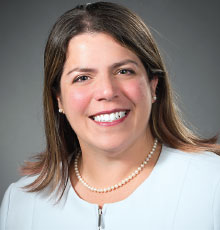Novel Medication Speeds Recovery From Postpartum Depression
Abstract
The FDA approval of the neuroactive steroid brexanolone for postpartum depression has prompted greater attention to how best to treat women experiencing debilitating sadness after birth.

Last March, the Food and Drug Administration (FDA) approved brexanolone (Zulresso) as the first medication specifically designed to treat postpartum depression (PPD). The advent of this potentially game-changing drug has sparked new interest in better understanding optimal treatment approaches for PPD and whether other novel therapeutics may similarly hold promise for recovery.
A Fast and Effective Discovery
Approximately 1 in 8 women in the United States will experience PPD—the constellation of severe and debilitating sadness, loss of interest in normally enjoyed activities or relationships, and other mood-related symptoms that can lead to adverse outcomes including suicide.
“Symptoms can begin during pregnancy or after delivery and can last several months to a year or more,” said Kristina M. Deligiannidis, M.D., an associate professor of psychiatry and obstetrics/gynecology at the Feinstein Institutes for Medical Research and the Zucker School of Medicine at Hofstra/Northwell. Symptoms of PPD differ from the postpartum “blues,” which typically go away within a few weeks of childbirth.
Without treatment, PPD can detrimentally impact both the mother and infant, underscoring the importance of timely and efficient therapeutics.

Only about 16% of women with postpartum depression receive treatment, and many in treatment continue to experience symptoms, says Kristina M. Deligiannidis, M.D.
Although evidence suggests antidepressants approved for the treatment of major depression are more effective than placebo at reducing symptoms of PPD, few studies have examined which antidepressants or psychological treatments are most effective.
“There are evidence-based psychotherapies and traditional antidepressants that can be helpful. But there are a sizable number of women who wouldn’t benefit from traditional therapies or the length of time between initiating these therapies and seeing benefits would be too long—taking weeks to months,” said Samantha Meltzer-Brody, M.D., M.P.H., chair of the University of North Carolina (UNC) School of Medicine’s Department of Psychiatry and director of the UNC Center for Women’s Mood Disorders. “For many women, that’s problematic because the onset of symptoms is severe and there is a need for fast-acting treatment that works within hours to days.”
Additionally, studies show that only about 16% of women with PPD receive treatment, Deligiannidis said. And of those, a mere 6% receive an intervention that provides what she described as “adequate” symptom relief.
“We must do better than this,” she said. “When women have not fully remitted from depression with the first antidepressant they are treated with, we must try additional antidepressant trials, alone or in combination, to maximize treatment benefit and minimize side effect burden.”
The approval by the FDA of the first medication for the treatment of PPD was supported by data from a randomized, controlled study by Meltzer-Brody, Deligiannidis, and their colleagues that was published in 2018.
Of 209 women randomized to treatment or placebo, those receiving a brexanolone infusion exhibited significantly greater rates of depression remission (Hamilton Depression Rating Scale [HAM-D] total score ≤7); at hour 60, approximately 50% of the women who received brexanolone remitted versus approximately 25% of those who received placebo. Treatment was also associated with greater chances of achieving depression response (≥50% reduction in HAM-D score) by hour 60 (approximately 75% of the brexanolone group versus 55% of the placebo group). The reduction in depression severity and speed at which the reduction was achieved were both greater with brexanolone than what has been seen in traditional oral antidepressant clinical trials. Severity improvements were also maintained during the 30-day study. Adverse effects were non-life threatening (for example, sedation and dry mouth), but some women required dose reduction.
“I can’t emphasize enough how amazing it is to see someone who has battled PPD with severe symptoms have a marked response and feel so much better within hours to days of the 60-hour infusion,” said Meltzer-Brody. “That’s a huge step forward in the field—our ability to treat someone that quickly.”
Flexible, Team-Based Approaches
Despite the optimism surrounding brexanolone, Meltzer-Brody noted that certain barriers exist that may impact patient access and benefit—namely, the need for health care professionals to alter how they implement PPD treatment.
Specifically, brexanolone is a 60-hour intravenous (IV) infusion, which is vastly more complicated than taking an oral pill. Effective delivery must be multidisciplinary, relying on clear communication and coordination among a team of physicians (including psychiatrists), specialists, nurses, and pharmacists who prescribe, verify dosing, administer the drug, monitor for interactions, and track response and outcomes.
Also, brexanolone is approved under the FDA’s Risk Evaluation and Mitigation Strategies program because in clinical trials, there were reports of increased sedation and a potential for risk of loss of consciousness if overly sedated. Thus, patients must be monitored in a hospital setting—yet another aspect of the treatment paradigm that needs to be sorted out.
Additional trials of other potential PPD medications are under way, which too may mean adopting new approaches to patient care. Deligiannidis and colleagues are currently examining oral SAGE-217 (Zuranolone) for severe PPD. Other researchers are looking at the effects of ketamine and of oral and IV ganaxolone. And the early success of brexanolone—a neuroactive steroid antidepressant—has sparked interest in other drugs within the same class, given their potential to positively modulate GABAA receptors.
“The FDA approval of a neuroactive steroid as an antidepressant is extremely exciting to our field as it is the first medication of its kind,” said Deligiannidis. “The research field is now wide open to discover how GABAergic agents work at the molecular and neurocircuitry levels. That research may lead to additional treatment targets.”
Meltzer-Brody similarly expressed optimism at the wave of potential new treatments for PPD but warned that psychiatrists must be prepared to think about new approaches to care rather than relying solely on traditional treatments.
“The postpartum period is such a vulnerable time, and there’s a great need for effective treatments that can work quickly,” she said. “We need to be open to figuring out new ways of delivering care so we can decrease suffering in patients. And something that can work very rapidly and have efficacy can be very appealing.” ■
“Brexanolone Injection in Post-partum Depression: Two Multicentre, Double-Blind, Randomised, Placebo-Controlled, Phase 3 Trials” is posted here.



